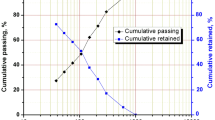Abstract
Removal of water-based filter cake formed during drilling and hydraulic fracturing operations is a difficult task. Conventional acids, such as hydrochloric acid, organic acid, or a mixture of these acids, can be used to remove the filter cake. The common issues of these acids are rapid and uncontrolled reaction rate and corrosion to well tubulars, especially in horizontal and deep wells. Chelating agents were introduced in the oil industry to solve the problems associated with the conventional acids. Up to the authors’ knowledge, the reaction of chelating agents with starch, which is a major component of the filter cake, was not investigated in the literature. The objectives of this study are to (1) assess the reaction of starch with different chelating agents, namely ethylenediaminetetraacetic acid (EDTA), glutamic acid diacetic acid (GLDA), and diethylene triamine penta-acetic acid (DTPA), at different conditions of pH and temperature, (2) evaluate the compatibility of chelating agents with enzyme [high thermally stable \(\upalpha \)-amylase enzymes (HTA)], (3) assess the reaction of enzyme with starch and xanthan gum, and (4) design the best scenario for calcium carbonate filter cake removal. The obtained results showed that EDTA (20 wt%, pH 7, and 12), DTPA (20 wt%, pH 7, and 12), and GLDA (20 wt%, pH 4, 7, and 12) were not able to break the starch after hot rolling for different time periods at \(200\,{^{\circ }}\hbox {F}\). Different chelating agents were found to be incompatible with \(\upalpha \)-amylase enzyme (HTA enzyme that should be used to remove the starch). The two-stage scenario was found to be the best practice to remove the calcium carbonate filter cake in 22 h with 100% removal efficiency and 100% retained permeability. Computer tomography confirmed that external and internal filter cake was completely removed, and no formation damage was existing.
Similar content being viewed by others
References
Elkatatny, S.M.; Mahmoud, M.A.; Nasr-El-Din, H.A.: Characterization of filter cake generated by water-based drilling fluids using Ct scan. SPE Drill. Complet. 27(2), 282–293 (2012)
Elkatatny, S.M.; Mahmoud, M.; Nasr-El-Din, H.: Filter cake properties of water-based drilling fluids under static and dynamic conditions using CT scan. J. Energy Resour. Technol. 135(4), 042201 (2013). doi:10.1115/1.4023483
Burnett, D.B.: Using a physical wellbore model to study formation damage problems in well completions. SPE Drill. Complet. 10(1), 61–65 (1995)
Rabia, H.: Well Engineering and Constructions. Entrac Consulting. ISBN: 0954108701 (2002)
Loebert, L.; Durand, C.; Lecourtier, J.; Rosenberg, E.: Relationship between composition structure and permeability of drilling filter cake. Rev. Inst. Fr. Pet. 51(6), 777–788 (1996)
Audibert, A.; Argillier, J.F.; Ladva, H.K.; Way, P.W.; Hove, A.O.: Role of Polymer on Formation Damage. Paper SPE 54767 presented at the European Formation Damage, The Hague, The Netherlands, 31 May–1 Jun (1999)
Price-Smith, C.; Bennett, C.; Ali, S.A.; Hodge, R.M.; Burton, R.C.; Parlar, M.: Open Hole Horizontal Well Cleanup in Sand Control Completions: State of the Art in Field Practice and Laboratory Development. Paper SPE 50673 presented at the European Petroleum Conference, The Hague, The Netherlands, 20–22 October (1998)
Parlar, M.; Tibbles, R.J.; Chang, F.F.; Fu, D.; Morris, L.; Davison, M.; Vinod, P.S.; Wierenga, A.: Laboratory Development of a Novel, Simultaneous Cake-Cleanup and Gravel-Packing System for Long, Highly-Deviated or Horizontal Open-Hole Completions. Paper SPE 50651 presented at the European Petroleum Conference, The Hague, The Netherlands, 20–22 October (1998)
TjonJoe-Pin, R.; Brannon, H.D.; Rickards, A.R.: Remedial Treatment for Polymeric Damage Removal Provides Improved Well Productivity, Paper SPE 25214 presented at the SPE International Symposium on Oilfield Chemistry, New Orleans, U.S.A., 2–5 March (1993)
Brannon, H.D.: Biotechnological Breakthrough Improves Performance of Moderate to High-Temperature Fracturing Applications. Paper SPE 28513 presented at the Annual Technical Conference and Exhibition, New Orleans, Louisiana, 25-28 September (1994)
Hembling, D.; Chan, A.; Garner, J.; Beall, B.: Using Enzymatic Breakers in Horizontal Wells to Enhance Wellbore Clean-Up. Paper SPE 58732 presented at the International Symposium on Formation Damage Control, Lafayette, Louisiana, 23–24 February (2000)
Al-Otaibi, M.B.; Nasr-El-Din, H.A.; Siddiqui, M.A.: Chemical Treatments to Enhance Productivity of Horizontal and Multilateral Wells: Lab Studies and Case Histories. Paper SPE 89467 presented at the Fourteenth Symposium on Improved Oil Recovery, Tulsa, Oklahoma, 17–21 April (2004)
Samuel, M.; Mohsen, A.H.; Ejan, A.B.; Ooi, Y.S.; Ashraf, S.; Nasr-El-Din, H.A.: A novel \(\alpha \)-amylase enzyme stabilizer for applications at high temperatures. SPE Prod. Oper. 25(3), 398–408 (2010)
Law, M.; Chao, G.W.; Alim, H.A.; Samuel, E.; Ejan, A.; Mohsen, A.H.; Samuel, M.: A Step Change in Open hole Gravel packing Methodology: Drilling-Fluid Design and Filter-Cake Removal Method. Paper SPE 105758 presented at the Middle East Oil and Gas Show and Conference, Kingdom of Bahrain, 11–14 March (2007)
Tibbles, R.J.; Parlar, M.; Chang, F.F.; Fu, D.; Davison, M.; Morris, L.; Wierenga, A.; Vinod, P.S.: Fluid and Techniques for Hydrocarbon Well Completion. US Patent No. 6140277. 31 October (2003)
Navarro-mascarella, R.; Luyster M.: High Density Breaker Fluids and Methods of Use Thereof. US patent No. 61870. 17 March (2011)
Collins, N.; Nzeadibe, K.; Almond, S.W.: A Biodegradable Chelating Agent Designed to be an Environmentally Friendly Filter-Cake Breaker. Paper SPE 140816 presented at the European Health, Safety and Environmental Conference in Oil and Gas Exploration and Production, Vienna, Austria, 22–24 February (2011)
LePage, J.N.; De Wolf, C.A.; Bemelaar, J.H.; Nasr-El-Din, H.A.: An environmentally friendly stimulation fluid for high temperature applications. SPEJ 16(1), 104–110 (2011)
Mahmoud, M.A.; Nasr-El-Din, H.A.; Wolf, C.D.; LePage, J.N.; Bemelaar, J.H.: Evaluation of a new environmentally friendly chelating agent for high-temperature applications. SPEJ 16(3), 559–574 (2011)
Elkatatny, S.M.; Nase-El-Din, H.A.: Removal of water-based filter cake and stimulation of the formation in one-step using an environmentally friendly chelating agent. Int. J. Oil Gas Coal Technol. 7(2), 169–188 (2014)
Elkatatny, S.M.: Evaluating the chemical reaction of chelating agents with Xanthan Gum. Arab. J. Sci. Eng. 42:1427–1434 (2017)
Author information
Authors and Affiliations
Corresponding author
Rights and permissions
About this article
Cite this article
Elkatatny, S., Mahmoud, M. Investigating the Compatibility of Enzyme with Chelating Agents for Calcium Carbonate Filter Cake Removal. Arab J Sci Eng 43, 2309–2318 (2018). https://doi.org/10.1007/s13369-017-2727-4
Received:
Accepted:
Published:
Issue Date:
DOI: https://doi.org/10.1007/s13369-017-2727-4




